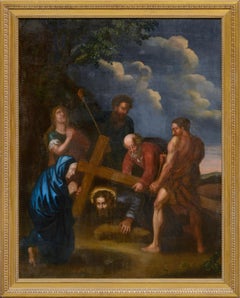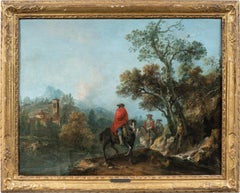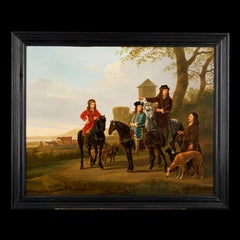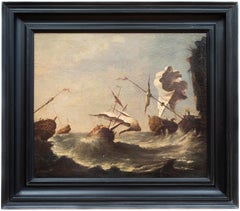Landscape Paintings
18th Century Romantic Landscape Paintings
Linen, Oil, Fiberboard
1670s Old Masters Landscape Paintings
Oil
18th Century Old Masters Landscape Paintings
Oil
Mid-18th Century Rococo Landscape Paintings
Canvas, Oil
17th Century Old Masters Landscape Paintings
Oil
18th Century Old Masters Landscape Paintings
Canvas, Oil
Early 18th Century Old Masters Landscape Paintings
Canvas, Oil
17th Century Old Masters Landscape Paintings
Oak, Oil, Wood Panel
Mid-18th Century Old Masters Landscape Paintings
Oil
Early 1700s Old Masters Landscape Paintings
Oil
Mid-18th Century Rococo Landscape Paintings
Canvas, Oil
Late 18th Century Old Masters Landscape Paintings
Pencil
18th Century Baroque Landscape Paintings
Canvas, Oil
1790s Old Masters Landscape Paintings
Oil
17th Century Old Masters Landscape Paintings
Oil
18th Century Old Masters Landscape Paintings
Oil
16th Century Mannerist Landscape Paintings
Oil, Wood Panel, Board
Early 18th Century Rococo Landscape Paintings
Canvas, Oil
1650s Landscape Paintings
Wood, Oil
17th Century Old Masters Landscape Paintings
Oil
Late 18th Century Modern Landscape Paintings
Oil, Canvas
Mid-18th Century Rococo Landscape Paintings
Canvas, Oil
17th Century Old Masters Landscape Paintings
Oil
18th Century Landscape Paintings
Oil
17th Century Old Masters Landscape Paintings
Oil
17th Century Old Masters Landscape Paintings
Oil
17th Century Old Masters Landscape Paintings
Oil
1730s Old Masters Landscape Paintings
Oil
Late 18th Century Romantic Landscape Paintings
Canvas, Oil, Board
17th Century Old Masters Landscape Paintings
Oil
18th Century and Earlier Other Art Style Landscape Paintings
Oil
17th Century Old Masters Landscape Paintings
Oil
Late 18th Century English School Landscape Paintings
Oil
Late 18th Century Baroque Landscape Paintings
Canvas, Oil
18th Century Old Masters Landscape Paintings
Oil, Wood Panel
18th Century Old Masters Landscape Paintings
Oil, Canvas
Early 18th Century Old Masters Landscape Paintings
Canvas, Oil
16th Century Old Masters Landscape Paintings
Oil
Late 17th Century Old Masters Landscape Paintings
Oil
Mid-18th Century Rococo Landscape Paintings
Canvas, Oil
18th Century Other Art Style Landscape Paintings
Oil
18th Century Old Masters Landscape Paintings
Oil
17th Century Old Masters Landscape Paintings
Oil
17th Century Old Masters Landscape Paintings
Oil
18th Century Old Masters Landscape Paintings
Oil
Mid-18th Century Baroque Landscape Paintings
Canvas, Oil
18th Century Flemish School Landscape Paintings
Oil
18th Century Other Art Style Landscape Paintings
Oil
16th Century Old Masters Landscape Paintings
Oil
18th Century English School Landscape Paintings
Canvas, Oil
17th Century Old Masters Landscape Paintings
Oil
18th Century Old Masters Landscape Paintings
Canvas, Oil
18th Century Landscape Paintings
Oil
18th Century Landscape Paintings
Oil, Panel
1690s Baroque Landscape Paintings
Canvas, Wood, Oil
1750s Landscape Paintings
Canvas, Oil
18th Century Old Masters Landscape Paintings
Oil
Late 17th Century Old Masters Landscape Paintings
Canvas, Oil
Shop Landscape Paintings on 1stDibs
It could be argued that cave walls were the canvases for the world’s first landscape paintings, which depict and elevate natural scenery through art, but there is a richer history to consider.
The Netherlands was home to landscapes as a major theme in painting as early as the 1500s, and ink-on-silk paintings in China featured mountains and large bodies of water as far back as the third century. Greeks created vast wall paintings that depicted landscapes and grandiose garden scenes, while in the late 15th century and early 16th century, landscapes were increasingly the subject of watercolor works by the likes of Leonardo da Vinci and Fra Bartolomeo.
The popularity of religious paintings eventually declined altogether, and by the early 19th century, painters of classical landscapes took to painting out-of-doors (plein-air painting). Paintings of natural scenery were increasingly realistic but romanticized too. Into the 20th century, landscapes remained a major theme for many artists, and while the term “landscape painting” may call to mind images of lush, grassy fields and open seascapes, the genre is characterized by more variety, colors and diverse styles than you may think. Painters working in the photorealist style of landscape painting, for example, seek to create works so lifelike that you may confuse their paint for camera pixels. But if you’re shopping for art to outfit an important room, the work needs to be something with a bit of gravitas (and the right frame is important, too).
Adding a landscape painting to your home can introduce peace and serenity within the confines of your own space. (Some may think of it as an aspirational window of sorts rather than a canvas.) Abstract landscape paintings by the likes of Korean painter Seungyoon Choi or Georgia-based artist Katherine Sandoz, on the other hand, bring pops of color and movement into a room. These landscapes refuse to serve as a background. Elsewhere, Adam Straus’s technology-inspired paintings highlight how our extreme involvement with our devices has removed us from the glory of the world around us. Influenced by modern life and steeped in social commentary, Straus’s landscape paintings make us see our surroundings anew.
Whether you’re seeking works by the world’s most notable names or those authored by underground legends, find a vast collection of landscape paintings on 1stDibs.




